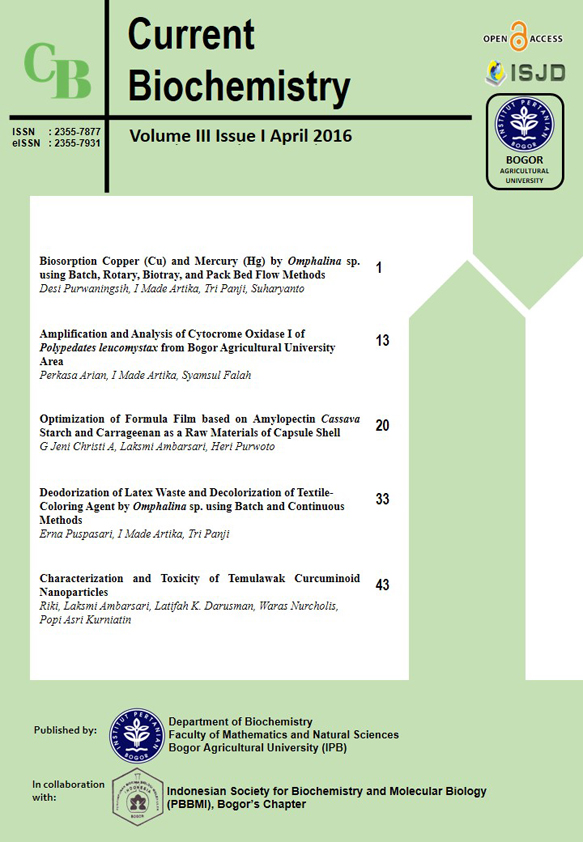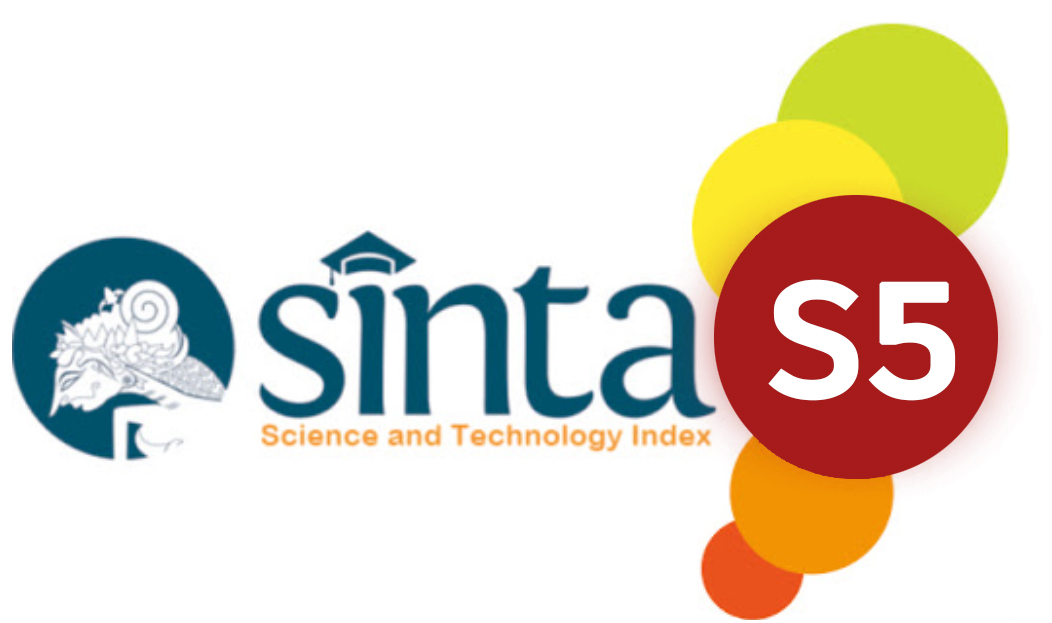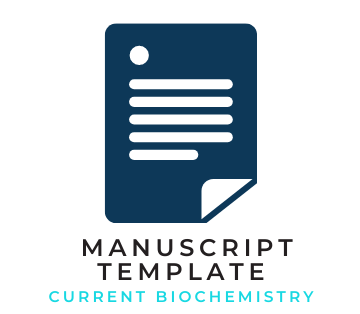Deodorization of Latex Waste and Decolorization of Textile-Coloring Agent by <i>Omphalina</i> sp. using Batch and Continuous Methods
Abstract
Generally industrial waste water is a pollutant to environment as it produces strong odor and color. Omphalina sp is one of white rot fungi that can be used as an odor and color effluent reducer. Omphalina sp has laccase enzyme that plays role in deodorization and decolorization. The aim of this research was to determine the best method in deodorization and decolorization among batch and continous (pack bed flow, biotray, and rotary contactor) methods. The results of deodorization and decolorization showed that the rotary contactor method was better than the batch, pack bed flow and biotray methods. At dye concentration of 50 ppm, after 24 hours treatment, the absorbance value for batch, pack bed flow, biotray, and rotary contactor methods was 0.520, 0.423, 0.425, and 0.357, respectively. At dye concentration of 150 ppm, after 24 hour treatment, the absorbance value for batch, pack bed flow, biotray, and rotary contactor methods was 0.709, 0.629, 0.658, and 0.592, respectively. At dye concentration of 50 ppm, percentage of dye absorption after 24 hour treatment for batch, pack bed flow, biotray, and rotary contactor methods was 20.550%, 35.447%, 35.141% and 45.531% respectively. At dye concentration of 150 ppm, percentage of dye absorption after 24 hour treatment for batch, pack bed flow, biotray, and rotary contactor methods was 7.320%, 17.843%, 13.987%, and 22.614%. The qmaks value at dye concentration of 50 ppm after 24 hour treatment for batch, pack bed flow, biotray, and rotary contactor methods was 0.020, 0.076, 0.083, and 0.124 respectively. qmaks value at dye concentration of 150 ppm after 24 hour treatmeny for batch, pack bed flow, biotray, and rotary contactor methods was 0.009, 0.077, 0.046, and 0.100 respectively. Odor scale for batch, pack bed flow, biotray, and rotary contactor methods decreased from 5 to 2.9, 1.4, 1.6 and 1.1 respectively.
References
Ardhina, A. 2007. Dekolorisasi limbah cair industri tekstil menggunakan Omphalina sp [Skripsi]. Bogor. Institut Pertanian Bogor.
Awaluddin R, et al. 2001. Decolorization of commercially available synthetic dyes by the white rot fungus Phanerochaete chrysosporium. J Fungi and Bactery. 62:55-63.
Azizah RN 2008. Deodorisasi Limbah Lateks Pekat dan Dekolorisasi Zat Pewarna Tekstil Secara Enzimatis dengan Formula Omphalina sp [Sripsi]. Bogor. Institut Pertanian Bogor.
Bakshi RK, Gupta KG, Sharma P. 1999. Enhanced biodecolourisation of synthetic textile dye effluent by Phanerochaete chrysosporium under improved culture conditions. World J Microbiol Biotechnol. 15:507–509.
Buckley KF, Dobson DW. 1998. Extracellular ligninolytic enzyme production and polymeric dye decolourisation in immobilized cultures of Chrysosporium lignorum CL 1. Biotechnol Lett 20:301–306.
Budiawan. 2001. Pengkajian Keputusan Menteri Lingkungan Hidup No.50/MenLH/II/1996 Tentang Resiko dan Keselamatan Lingkungan. [Laporan penelitian]. Depok: Fakultas Matematika dan Ilmu Pengetahuan Alam, Universitas Indonesia. Jakarta.
Dimawarnita F, et al. 2015. Biosorpsi ion tembaga dalam limbah tailing menggunakan jamur pelapuk putih amobil. Menara Perkebunan. 83(1): 27-36.
Gill PK, Arora DS, Chander M. 2002. Biodecolourisation of azo and triphenylmethane dyes by Dichomitus squalens and Phlebia spp. J Ind Microbiol Biotechnol 28:201–203.
Kosasih H. 2003. Studi deodorisasi pada lateks secara mikrobiologi menggunakan isolat bakteri. Skripsi (tidak dipublikasikan). Fakultas Matematika dan Ilmu Pengetahuan Alam, Universitas Indonesia. Jakarta.
Robinson T, Chandran B, Nigam P. 2001. Studies on the decolourisation of an artificial textile effluent by white-rot fungi in N-rich and N-limited media. Appl Microbiol Biotechnol. 57:810–813.
Stolz A. 2001. Basic and applied aspects in the microbialdegradation of azo dyes. Appl Microbiol Biotechnol 56:69–80.
Thurston CF. 1994. The structure and function of fungal laccase. Microbiology. 140: 19-26.
Van der Zee. 2002. Anaerobic azo dye reduction [Thesis]. Wageningen University. Nedherlands.
Wesenberg D, Buchon F, Agathos SN. 2002. Degradation of dye containing textile effluent by agaric white-rot fungi Clitocybula dusenii. Biotechnol Lett 24:989–993.













